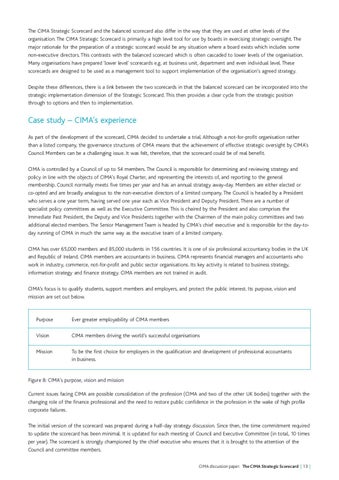The CIMA Strategic Scorecard and the balanced scorecard also differ in the way that they are used at other levels of the organisation. The CIMA Strategic Scorecard is primarily a high level tool for use by boards in exercising strategic oversight. The major rationale for the preparation of a strategic scorecard would be any situation where a board exists which includes some non-executive directors. This contrasts with the balanced scorecard which is often cascaded to lower levels of the organisation. Many organisations have prepared ‘lower level’ scorecards e.g. at business unit, department and even individual level. These scorecards are designed to be used as a management tool to support implementation of the organisation’s agreed strategy. Despite these differences, there is a link between the two scorecards in that the balanced scorecard can be incorporated into the strategic implementation dimension of the Strategic Scorecard. This then provides a clear cycle from the strategic position through to options and then to implementation.
Case study – CIMA’s experience As part of the development of the scorecard, CIMA decided to undertake a trial. Although a not-for-profit organisation rather than a listed company, the governance structures of CIMA means that the achievement of effective strategic oversight by CIMA’s Council Members can be a challenging issue. It was felt, therefore, that the scorecard could be of real benefit. CIMA is controlled by a Council of up to 54 members. The Council is responsible for determining and reviewing strategy and policy in line with the objects of CIMA’s Royal Charter, and representing the interests of, and reporting to the general membership. Council normally meets five times per year and has an annual strategy away-day. Members are either elected or co-opted and are broadly analogous to the non-executive directors of a limited company. The Council is headed by a President who serves a one year term, having served one year each as Vice President and Deputy President. There are a number of specialist policy committees as well as the Executive Committee. This is chaired by the President and also comprises the Immediate Past President, the Deputy and Vice Presidents together with the Chairmen of the main policy committees and two additional elected members. The Senior Management Team is headed by CIMA’s chief executive and is responsible for the day-today running of CIMA in much the same way as the executive team of a limited company. CIMA has over 65,000 members and 85,000 students in 156 countries. It is one of six professional accountancy bodies in the UK and Republic of Ireland. CIMA members are accountants in business. CIMA represents financial managers and accountants who work in industry, commerce, not-for-profit and public sector organisations. Its key activity is related to business strategy, information strategy and finance strategy. CIMA members are not trained in audit. CIMA’s focus is to qualify students, support members and employers, and protect the public interest. Its purpose, vision and mission are set out below.
Purpose
Ever greater employability of CIMA members
Vision
CIMA members driving the world’s successful organisations
Mission
To be the first choice for employers in the qualification and development of professional accountants in business.
Figure 8: CIMA’s purpose, vision and mission Current issues facing CIMA are possible consolidation of the profession (CIMA and two of the other UK bodies) together with the changing role of the finance professional and the need to restore public confidence in the profession in the wake of high profile corporate failures. The initial version of the scorecard was prepared during a half-day strategy discussion. Since then, the time commitment required to update the scorecard has been minimal. It is updated for each meeting of Council and Executive Committee (in total, 10 times per year). The scorecard is strongly championed by the chief executive who ensures that it is brought to the attention of the Council and committee members. CIMA discussion paper: The CIMA Strategic Scorecard | 13 |
